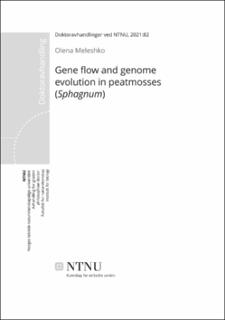| dc.contributor.advisor | Professor Kristian Hassel,
Professor Hans Kristian Stenøien | |
| dc.contributor.author | Meleshko, Olena | |
| dc.date.accessioned | 2021-03-12T12:12:53Z | |
| dc.date.available | 2021-03-12T12:12:53Z | |
| dc.date.issued | 2021 | |
| dc.identifier.isbn | 978-82-326-5605-9 | |
| dc.identifier.issn | 2703-8084 | |
| dc.identifier.uri | https://hdl.handle.net/11250/2733162 | |
| dc.description.abstract | Speciation is one of the most fundamental evolutionary processes, as it creates biodiversity. Gene flow, or introgression, can bring genetic novelty into recipient species, and hence promote adaptation, while simultaneously being antagonistic to establishment of reproductive isolation between the hybridising species. Gene flow is believed to be especially important for speciation in plants. Studying genomes of diversifying lineages enables the identification of the genomic footprints of gene flow, which facilitates disentangling its role for speciation from that of other evolutionary forces, such as selection and genetic drift. This remains challenging in non-model and nonvascular plants, where comprehensive genomic resources are lacking, and the role of gene flow for speciation remains poorly understood. In this thesis, speciation with gene flow is studied on the genomic level in a bryophyte genus of peatmosses. Peatmosses (Sphagnum) are described by recent rapid diversification, frequent hybridisation, ancient history, phenotypic and ecological plasticity, and huge ecological importance. The combination of these features makes them an excellent model for studying the genomics of speciation in general, and the long-standing question of the evolutionary significance of introgression in particular.
First, I explored the extent of gene flow in the genus and its relation to phylogenetic divergence and variation in key life-history traits of the hybridising species, based on the published literature. I showed that hybridisation is very common in the genus, but mostly takes the form of allopolyploid hybridisation, where two haploid species produce a diploid hybrid species. I also found that species with monoicous and polyocious mating systems, high sporulation frequency and smaller spores that prefer poor habitats tend to produce more hybrids than other species. However, variation in key life-history traits and phylogenetic relatedness do not fully explain the occurrence of hybridisation in the genus. Then, I focused on the relative importance of introgression, in the form of hybridisation without change in chromosome number, for genome evolution compared to stochastic coalescent processes. I sampled populations of twelve haploid species representing all Sphagnum subgenera and performed low-coverage whole-genome sequencing. Contrary to expectations, I did not find evidence of widespread recent gene flow. Instead, the results suggest that ancestors of the extant subgenera exchanged genes in the past, which might have fueled rapid radiation of the genus. I also demonstrated extensive genome-wide phylogenetic discordance, which was due to incomplete sorting of ancestral polymorphism following the rapid radiation of the genus, and not due to gene flow. Finally, I tested how selection and genomic architecture influenced genome evolution in these twelve species. I described and compared the genomic distribution of diverse measures of genetic diversity, phylogenetic discordance and density of genomic features. The results suggest that genome evolution was likely constrained by conserved genomic architecture, leading to similar effects of linked selection in different species.
Overall, the findings suggest that, in contrast to many other groups with a known history of hybridisation, gene flow is not a prominent driver of genome evolution in peatmosses relative to selection and incomplete lineage sorting, at least not in the studied species. The results also corroborate the idea suggested in other studies that evolutionary processes in land plants may be universal, since rapid radiation creates very similar phylogenomic patterns across bryophytes and angiosperms. The thesis suggests that the genome evolution in Sphagnum might involve strong positive divergent selection and gene flow in the ancestor populations, whereas at the later stages of speciation, their genomes became shaped mainly by purifying selection and incomplete lineage sorting, constrained by genomic architecture. | |
| dc.language.iso | eng | en_US |
| dc.publisher | NTNU | en_US |
| dc.relation.ispartofseries | Doctoral theses at NTNU;2021:82 | |
| dc.relation.haspart | Paper 1: Meleshko, Olena; Stenøien, Hans K.; Speed, James David Mervyn; Flatberg, Kjell Ivar; Kyrkjeeide, Magni Olsen; Hassel, Kristian. Is interspecific gene flow and speciation in peatmosses (Sphagnum) constrained by phylogenetic relationship and life-history traits?. Lindbergia 2018 ;Volum 41
https://doi.org/10.25227/linbg.01107
https://doi.org/10.1093/molbev/msab063
This is an Open Access article distributed under the terms of the Creative Commons Attribution License (CC BY 4.0)
(http://creativecommons.org/licenses/by/4.0/) | en_US |
| dc.relation.haspart | Paper 2: Meleshko, Olena; Martin, Michael David; Korneliussen, Thorfinn Sand; Schröck, Christian; Lamkowski, Paul; Schmutz, Jeremy; Healey, Adam; Piatkowski, Bryan T; Shaw, A. Jonathan; Weston, David J; Flatberg, Kjell Ivar; Szövényi, Péter; Hassel, Kristian; Stenøien, Hans K.. Extensive genome-wide phylogenetic discordance is due to incomplete lineage sorting and not ongoing introgression in a rapidly radiated bryophyte genus. Molecular Biology and Evolution (MBE) 2021
https://doi.org/10.1093/molbev/msab063
This is an Open Access article distributed under the terms of the Creative Commons Attribution License (CC BY 4.0)
(http://creativecommons.org/licenses/by/4.0/) | en_US |
| dc.relation.haspart | Paper 3:
Meleshko, Olena; Szövényi, Péter; Martin, Michael David; Flatberg, Kjell Ivar; Stenøien, Hans K.;Hassel, Kristian.
Genome-wide patterns of diversification are shaped by selection, ancient intorgression and incomplete lineage sorting in a rapidly radiated genus of peatmoss | en_US |
| dc.title | Gene flow and genome evolution in peatmosses (Sphagnum) | en_US |
| dc.type | Doctoral thesis | en_US |
| dc.subject.nsi | VDP::Mathematics and natural science: 400::Basic biosciences: 470 | en_US |

